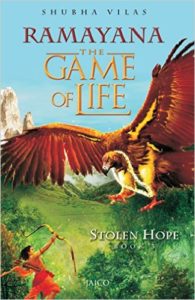Ramayana and Mahabharata are perhaps the oldest stories in Indian philosophy. Written by a seer named Valmiki, Ramayana is the story of Rama, son of Dashratha, of the Ikshvaku clan. It is supposed to pre-date the other Indian epic, Mahanbharata.
Both these poems or stories show the readers the complexities of human nature and its vices. Reading between the lines, and by listening to the dialogues between the characters and monologues of seers, the text provide some insight into Indian philosophy.
Ramayan specifically talks about the dharma of ideal Son, an ideal king, and an ideal husband. But it also has many other characters and situations that emphasize interrelations with ones teachers and friends.
In Book 3, Stolen Hope, of Ramayana: The Game of Life, Shubha Vilas covers the period after King Dashratha, under the influence of kaikaeyi has banished Rama from the kingdom. Shubha Vilas is a motivational speaker and spiritual seeker. He aims to connect people with the old dhrama text of Indian philosophy and resolve the modern-day problems from lessons in these dharmic texts.
 Ramayana: The Game of Life – Book 3 – Stolen Hope
Ramayana: The Game of Life – Book 3 – Stolen Hope
Pages: 296
Publisher: Jaico Publishing House; 1 edition (December 30, 2015)
ASIN: B019ZFKQ0Y
All of the original work is written in sanskrit, which is not the common medium of language anymore. Shubha Vilas’ translation of these texts into easy-to-read English text gives readers an opportunity to explore these texts in more detail.
Almost everyone knows the story of Ramayana and Mahabharata at a higher level. But what is more important is the text and interactions between the characters that hide the teachings of Indian philosophy.
With footnotes explaining he reasoning behind the sequence of events and dialogues, Shubha Vilas brings forth the teachings of these texts to the readers. His interpretations of the text and views will nudge the reader to think what Valmiki may have wanted to tell his readers thousands of year ago.
The world we live in has changed drastically compared tothe times at which these texts were written. But human nature has failed to evolve much during this time. We still have a jealous Kaikeyi amongst us and we still have to be aware of the Ravanas around us. Our temptations, desires, and vices have changed, but the underlying forces are the same.
With so much deception and evil, this part of Ramayana shows us the value of love and devotion. Ramayana: The Game of Life not only tells this story in details, but also makes you think and look behind the actions and words of the different characters, each carefully chosen to send a message to the readers.